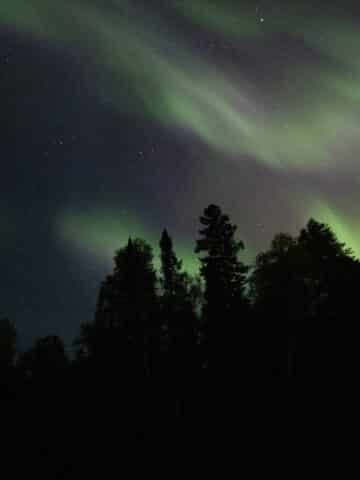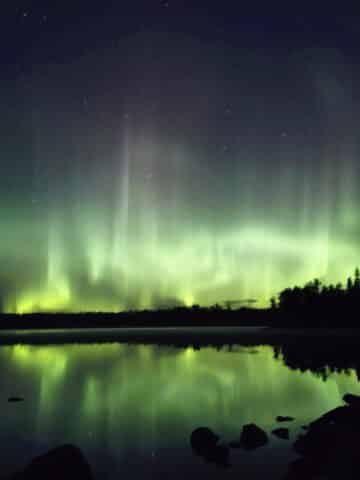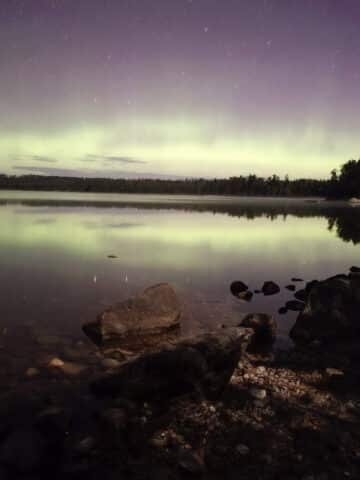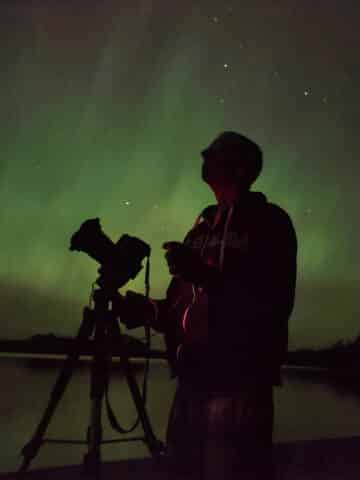Wondering if you'll be able to see the Northern Lights tonight? Here's how to understand aurora borealis apps & forecast models, to improve your chances!

This guide will help you sort out the data for your own prediction of the aurora show.
Aurora Borealis is a natural phenomenon that occurs when material and energy from the sun interact with Earth's magnetic field, specifically in the Northern Hemisphere.
Aurora Australis – Southern Lights - is the same effect in the Southern Hemiphere, and this guide will help our southern friends as well.
Perhaps it's been on your bucket list to see auroral activity. Whether you hope to see northern lights tonight or want to learn to make your own aurora predictions, this guide will break down the basics of what to look for.
There are a lot of parameters that serious aurora watchers will look for, and discuss in forums. I'll dissect them and show you the basics about each.

A Note On Photography
Every photo on this post - and throughout the series - are photos we took on our various camping and aurora hunting trips.
Most were taken on a Samsung Galaxy s24, some were taken with a Canon R7.
All rights reserved - images may not be reproduced, copied, downloaded or transmitted in any form or manipulated without the written permission of Marie & Michael Porter, 2 Nerds in a Truck.
How to Photograph the Northern Lights - Tips for Camera & Phone Photography
Aurora Hunting: How to See the Northern Lights
Where to See Northern Lights in Ontario

What to Keep In Mind
A lot of things need to align to get a good show, which is part of why it's so uncommon for people to see without planning.
Here's a quick list of things to consider:
Weather Conditions
The aurora show is always "weather permitting"! Intense cloud cover, particularly toward the north, can block your show.
This can force you to need a different location at the last minute.
It's best to have a list of the best locations that you're willing to travel to see the show, so you can check the weather forecast and can pick the best viewing location for the visibility tonight.
Clear skies are best, but some cloud cover can be totally fine, and can even enhance photos by providing visual interest.
The other part of the weather to consider is precipitation. It's not really fun to stand out in the rain for very long.
The further north you are, the better, so snow is another consideration. A 4-wheel drive vehicle is a good idea if you're planning on being in rural areas when it's snowing.

"Night" Means More Than “After Sunset”
Wouldn't it be great if we could see the Northern lights just minutes after sunset?
It certainly would be convenient, but unfortunately it's very rare for that to occur.
Generally speaking, you won't be able to see anything until about an hour after sunset, through about an hour before sunrise. You can probably push that to ½ hour in each direction for a really bright show.
You need a really dark night sky for the best chance to see aurora.
Not only do we have to wait for more complete darkness, there's no guarantee on timing throughout the night.
You might catch a show shortly after sunset, it might not happen until 2am, it might not happen until 4am.

Cameras Can See Better Than Human Eyes
By eye, the aurora show will mostly present as white, MAYBE with some faint color showing.
It often isn't very bright, can look similar to far off city glow or very first light before sunrise. Bring a camera to capture the best images.
A Tripod is Necessary for Photography
Much more detail is provided in our post about how to photograph the northern lights but the bare minimum equipment is a digital camera (camera phone works) and a tripod.
You simply cannot hold a camera still enough for the several-second exposure needed to capture images. Hand held = You're going to have blurry photos.

Have Locations in Mind Before You Need Them
Again, a lot more detail is provided in our post about how to see aurora, but in general you want a good, open northern view (not a big wall of trees immediately in front of you) away from city lights.
Also think about safety, pulling over on a highway isn't as safe as pulling over on a rural residential road.
Asking where to find a good location the day of an event isn't likely going to net you a good experience, you'll want to scout them out in advance.
See our post Aurora Hunting: How to See the Northern Lights for more information on finding your perfect spot!

Share the Love!If you’ve made one of our recipes, be sure to take some pics of your handiwork! If you post it to Bluesky, be sure to tag us - @2NerdsInATruck, or you can tag us on TikTok, if you’re posting video. We're also on Pinterest, so you can save all your favourite recipes and park reviews to your own boards! Also, be sure to subscribe to our free email newsletter, so you never miss out on any of our nonsense. Well, the published nonsense, anyway! |
Information Sources & App Recommendations
Much of the data ultimately comes from NOAA – National Oceanic and Atmospheric Administration, based in the United States.
There are three places where I look for my data:
Data from NOAA
NOAA has 30-minute forecasts which displays a video of the last 24 hours of auroral activity, and at the end a short prediction for the next half hour.
Green shows a modest chance of activity, while yellow and red are increasing chances of activity. What you are hoping for is a nice, wide band with lots of red.
It's great to see how conditions are while it's still light out, but once it's dark you want to be at or near a viewing location so don't wait until the show is strong before even heading out!
NOAA also has what it calls an “experimental” Aurora Dashboard that forecasts tonight's and tomorrow's aurora likelihood.
Personally I find these graphs are usually very optimistic – I often see very strong predicted shows that don't actually turn into northern lights activity.
On the other hand, we've had "surprise" shows that turned out much more intense than was predicted.

My Aurora Forecast App
The My Aurora Forecast app is popular, based on what I see in aurora chat forums. It has a lot of the parameters that I detail below, but not all of them.
Their current aurora map allows you to zoom into your specific area, which is nice.
The app can push notifications to you about rising conditions, but I have them disabled because I use a different app (Next!)
Note: This Aurora app is free with ads, pay to remove ads.
Google Play: https://play.google.com/store/apps/details?id=com.jrustonapps.myauroraforecast
AppleStore: https://apps.apple.com/ca/app/my-aurora-forecast-alerts/id1073082439

SpaceWeatherLive App
Space Weather Live is my go-to source for auroral information, I think it's the best app available, and it's also a popular app discussed in forums.
I have aurora alerts set up with their free push notifications.
There's a large list of parameters with charts on the main screen, and in the menus you'll find much more data to help you predict an aurora show.
Google Play: https://play.google.com/store/apps/details?id=com.spaceweatherlive.app
Apple Store: https://apps.apple.com/ca/app/spaceweatherlive/id1435501021
Note: TheSpaceWeatherLive app is free with ads, and you can pay to remove those ads.

What Does Each Parameter Mean?
The following describes the basics of each parameter, mostly in order of how you view it on the SpaceWeatherLive app.
Much like anything scientific, you could dig into any one of these and make a career out it if you'd like.
For our purposes, knowing the basics is plenty sufficient for us to make an aurora forecast.

Kp Index
This is by far the most discussed parameter when it comes to northern lights. It's the planetary K Index and ranges from 0 to 9.
Think of this as a number that relates to “how far south might I see aurora right now?” I know from experience that in my area - Southern Ontario - I hope for Kp4 or higher for a decent show.
When I'm travelling further north, Kp3 could still give me a really good show. The further south you are, the higher number you'll need for the possibility of a good show.
Keep in mind this is an over-simplification of the Kp Index. Furthermore ... the Kp Index is often overused.
It's a good way to see how current conditions are, and it's a pretty good way to quickly discuss how auroral activity may present in the future.
Also, there are plenty of times where there's a high Kp but no auroral show.
Conversely - one time when we were visiting Quetico Provincial Park, up north? We saw a wild show at only a kp of 2.
Remember, the show is an interaction between charged particles that the sun is hurling at us and Earth's magnetic field.
Both have to align correctly to have a good show.
Pro tip: in SpaceWeatherLive, find the menu, select Auroral Activity > Kp-index. Now you can see Kp predictions in 3-hour blocks.
This is handy for planning whether you stay up late, or get up early for a show. Again, these are predictions, don't rely too heavily on them.

Solar Wind Speed
The solar wind speed is telling us how fast the sun is throwing charged particles at us. When a show is about to start, there's often a sharp increase in solar wind speed.
Due to satellites, we obtain these data about an hour before it gets to earth, perhaps only a half hour if the speed is high.
Numbers in the range of 300 – 450 km/sec are normal, what we see when conditions are calm.
What I look for is a sharp bump in the graph up to 500 or more (600 or 700+ is better yet!). This could mean we're about to be hit with a storm, make sure you're setup and ready to shoot soon!

Solar Wind Density
Solar wind density is simply listed as Density on the SpaceWeatherLive app, this is telling us the density of the charged particles coming in to Earth's atmosphere.
Calm levels may be less than 1, active levels will generally be higher – perhaps 5 or more could see a show, and this number can get much higher than that.
SpaceWeatherLive says over 60 is a very high density, for reference.
The solar wind data from Solar Wind Speed and Solar Wind Density work together to determine the amount of charged particles entering Earth's magnetic field.
More is better!
They're a great short-term prediction tool that tells us when an expected coronal mass ejection is about to hit us.

Interplanetary Magnetic Field
Bt is the combined magnetic strength of the incoming particles.
Higher numbers mean more intense conditions. Calm values tend to be under 10 nanoTeslas, whereas greater than 10nT indicates good conditions for a show.
I tend to skim past this and look closer at the next reading:
Bz is the magnetic strength specifically in the north-south direction. This is an important one for auroral activity!
We want to see negative values here. This means the charged particles are the opposite of Earth's magnetic field, and since opposite magnetic fields attract, it pulls in the charged particles.
The larger the value in the negative direction, the better! You'll often see this graph flip-flop from North to South quite a bit.
If the value are positive (north), you *might* still get a show (particularly if the Solar Wind Speed is high), but cross your fingers for it to flip negative (south) for the auroral intensity to increase.

Auroral Oval
This is a graphical analysis of the likelihood of seeing Aurora Borealis overlaid on an image of Earth.
In the SpaceWeatherLive app this graph is the 30-minute to 60-minute prediction, similar to the last few frames of the NOAA 30-minute forecast.
I keep an eye on this earlier in the day when a long storm is projected. I can see how intense the conditions are in Europe and use that to estimate how good of a show it could be for me, if conditions persist.
This is also a good tool to predict when a show is ending. When you're standing on a windy beach in winter, you want to know when it's time to go home!
Hemispheric Power
This is a nice little graph that shows the total energy input into the atmosphere. I like it because it's a quick way to see if conditions are rising or falling.
When you see red coming into the graph, you know good conditions are about to hit us.
As it fades to green, the show is likely fading away as well.

Magnetometers
The magnetometers measure Earth's magnetic field, and large changes can mean geomagnetic storm activity – which is what we want to see.
I leave this set to the CANMOS (Canada) set of data. I keep an eye on the Ottawa data, second from the bottom, which is closest to my location.
When I see yellow and orange sets, it's an indicator to me that strong activity is occurring in my area which could represent a good northern lights show.
I don't rely heavily on this graph, it's more of a confirmation of activity to me.

Disturbance Storm Time Index
This measures what is called ring current around the equator. What we're looking for is low numbers – ideally high value negative numbers - which indicates a lot of energy in Earth's magnetosphere.
This is another important number, an easy way to see if there's an active storm or one about to hit.
-50 nanoTeslas and below are considered a moderate geomagnetic storm. -100nT and below are considered a strong storm.
In my experience you're not likely to have a good show unless this is -25nT or lower.

Moon Phase
The light from the moon makes a huge difference in how your photos will turn out.
A new moon means you'll have very dark conditions, provided you're away from bright city lights.
A full moon on the other hand will wash out the show somewhat, but it also can be fun to illuminate your foreground, providing context to the photos.
I generally try to avoid the moon, looking at not only the moon phase, but moonrise and moonset for the day.
SpaceWeatherLive does not display moonrise and moonset data. I use TimeAndDate.com to see the next moonrise and moonset.

Solar Flares
In the SpaceWeatherLive app, find the menu and select Solar Activity > Solar Flares. The graph you see shows the intensity of recent flares.
A solar flare that ejects charged particles – called a coronal mass ejection or CME – may or may not be earth directed.
In general, a large, Earth-directed flare is capable of producing an aurora show in about three days.
Coronal Mass Ejection – CME
In the SpaceWeatherLive app, find the menu and select Solar Activity > Latest CMEs. There's a lot of data presented, but one simple thing to look for is the Halo column.
Since the satellite that watches the Sun is directly between Earth and the Sun, if the satellite sees a ring – a halo – of ejected material, it means that it's likely that the ejection is straight toward Earth.
Scroll down the list and you'll see some of them have a roman numeral and color indicator. These are the CMEs of particular interest, as they have determined that the angle indicates material directed toward Earth.
A combined strong solar flare and CME that is directed toward Earth sets the stage for a good show.
When these occur, you'll often see it in the news and in forums. Gather your gear, check the weather, and get your plans in place!

Coronal Holes
Coronal holes are another source of particles that can create northern lights, but in general the big shows are from CMEs coming off a solar flare.
I don't monitor for coronal holes, but I do get push notifications for them on occasion.

How to Understand The Aurora Forecast
The predicted Kp is a reasonable way to forecast an aurora borealis show, but the key thing to remember is that it's extremely difficult to predict the time.
There may be a large solar flare with an Earth-directed CME, and the Kp is predicted to be high two days later.
The next day you might see that it's been pushed back a day. This makes it difficult to schedule your aurora watching trip!
I've seen plenty of times where the Kp is high, but there's no significant aurora display.
Conversely, I've seen nice shows in just Kp2 conditions. Thus a high Kp is a good sign, but doesn't guarantee aurora activity.
This is certainly frustrating, but it's also part of the fun! It's what makes aurora hunting an interesting challenge.
Keep an eye out on all of the stats, especially the ones noted as very important for aurora.
Also keep an eye on group chatter on places like Facebook, as there are lots of people interested that love to share and help.
Anyway, if you've made it this far, congrats! You should have a pretty good handle on figuring out the auroral forecasts now.
Good luck, and happy hunting!
Places To See The Northern Lights
Looking for a few ideas on where to start with your Aurora Borealis hunting? We're a big fan of aurora hunting at Provincial Parks.
There's a BIG caveat here, though: You must be a registered CAMPER in order to be in the parks after 10 pm. Otherwise, expect some big fines.
Looking to book a camping spot to see the show? Here are a few suggestions!
Arrowhead Provincial Park
Awenda Provincial Park
Big Bay, Ontario
Bon Echo Provincial Park
Bruce Peninsula National Park
Canisbay Lake, Algonquin Provincial Park
Chutes Provincial Park
Driftwood Provincial Park
Killbear Provincial Park
Lake Superior Provincial Park
Pancake Bay Provincial Park
Pinery Provincial Park
Quetico Provincial Park
Sleeping Giant Provincial Park

Thanks for Reading!If you loved this post - or have any questions about it - please leave a comment below! We'd also love it if you would consider sharing the link on social media! |







Leave a Reply